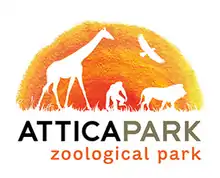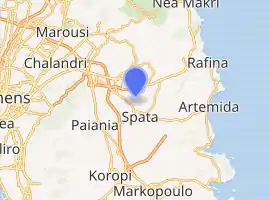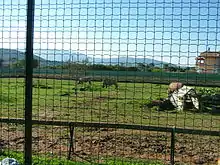Attica Zoological Park
Attica Zoological Park, is a 20-hectare (49-acre) private zoo located in the Athens suburb of Spata, Greece. The zoo is home to about 2000 animals representing 290 species, and is open 365 days per year.[2]

 Attica Zoological Park | |
| Date opened | 2000 |
|---|---|
| Location | Spata, Greece |
| Coordinates | 37.981243°N 23.907377°E |
| Land area | 20 ha (49 acres)[1] |
| No. of animals | 2000[2] |
| No. of species | 290+[2] |
| Memberships | EAZA[3] and EAAM |
| Major exhibits |
|
| Owner | Jean-Jacques Lesueur |
| Location | |

| |
| Website | www |

Attica Zoological Park is a member of the European Association of Zoos and Aquaria (EAZA).And the European association of Aquatic mammals (EAAM).
History
It opened in May 2000, initially as a Bird Park, hosting the 3rd largest bird collection in the world (1.100 birds from 300 different species), farm animals for the younger visitors and 3 very impressive walk-in aviaries – miniatures of the 3 continents – in which visitors can walk and admire the relevant bird fauna and flora.[1]
World of reptiles was added in April 2001, followed by Greek fauna in 2002, the African Savannah exhibit in 2003, a cat exhibit and expansion of the African Savannah exhibit in 2004, a monkey exhibit in 2005, Land of the Cheetah, a chimpanzee and siamng gibbons exhibit, and a desert exhibit (with bactrian camels and Somali wild asses) in 2008.[1]
In 2010, the zoo opened a dolphinarium and added Southern white rhinos to its residents.[1]
World of Reptiles
World of Reptiles opened in April of 2001 and it was the first addition to the zoo after its opening. Among the species in the "World of Reptiles" are cane toads, texas rat snakes, New Guinea viper boas, yellow anacondas, a Nile crocodile and radiated tortoises.
Greek Fauna
The "Greek Fauna" exhibit opened the following year in the summer of 2002 and includes species rarely seen in Greece.This exhibit features wild boars, fallow deers and the endangered Cretan wild goat also known as the Kri-Kri.
African Savannah

The "African Savannah" is an Africa-themed area that was opened in February of 2003 and it's the largest exhibit in the zoo. Animals on display in this area include the reticulated giraffe, Grant’s zebras, Kafue lechwes and the South African ostrich. Sometimes Arabian oryxes and Scimitar oryxes can be viewed in the "African Savannah" too.

Animals
The zoo's big cats include lions and Sumatran tigers, as well as cougars and Persian leopards. The zoo has several walk-through enclosures, including a "monkey's jungle".In December of 2015, two male Asian Elephants arrived at the Park
Shows
In 2005, the zoo began to run daily shows featuring birds of prey. In 2010 the zoo began shows with its newly installed dolphinarium showing sea-lions and dolphins.
The park have 7 dolphins : Veera (F), Leevi (M), Eevertti (M), Lima (M), Nojus (M), Ekinox (M) and Naska (M).
The future
Future plans include a museum of evolution with its primary focus on dinosaurs, called Dinosauropolisan, and an aquarium an Aquarium of international stature. [1]
Criticism
In June 2010 the dolphinarium started working with shows by sea lions and dolphins. There were initially four dolphins bought from the Lithuanian Marine Institute, then seven more were added from the same source. The Greek Green Party took Attica Zoological Park to court claiming animal welfare issues in 2011. In April 2011, a Provisional Order was issued by the Athens Court temporarily prohibiting the operation of the dolphinarium.[4] BBC has sent a correspondent to cover the story[5] and the controversy has been presented in an article by author Lauren St John in The Sunday Times.[6] In August 2011, the Greek court issued a decision declaring itself not competent to pass judgement on the case. Although the zoo claimed that the case in question has been decided permanently and that the company has been vindicated, this decision only addresses the ability of this particular court to decide the issue.[7]
Notes
- "History of the Park". atticapark.com. Attica Zoological Park. Archived from the original on 9 April 2012. Retrieved 3 December 2010.
- "Zoo". atticapark.com. Attica Zoological Park. Archived from the original on 2010-11-19. Retrieved 3 December 2010.
- "EAZA Member Zoos & Aquariums". eaza.net. EAZA. Retrieved 5 December 2010.
- "Greek Green Party Announces Prohibition Of Dolphin Shows". wdcs.org. WDCS International. Retrieved 5 July 2010.
- "BBC - Greek dolphin park prompts animal welfare row". BBC. Archived from the original on 13 July 2011. Retrieved 5 July 2011.
- Saint, John (20 March 2011). "Dolphins: Blood in the water". timesplus.co.uk. The Sunday Times. Retrieved 19 May 2012. (requires login)
- "Our Fight to Save the Dolphins at Attica Zoological Park in Greece Continues". ecogreens-gr.org. Greek Green Party. 22 September 2011. Retrieved 19 May 2012.
External links
 Media related to Attica Zoological Park at Wikimedia Commons
Media related to Attica Zoological Park at Wikimedia Commons- Official website (in English and Greek)
- https://athensattica.com/things-to-do/parks/attica-zoological-park/
- https://www.myguideathens.com/things-to-do/athens-attica-zoo-and-shopping-combo-full-day-tour